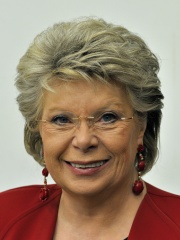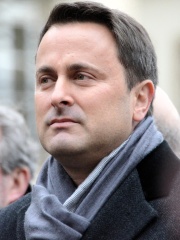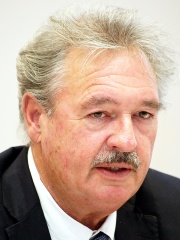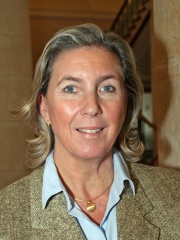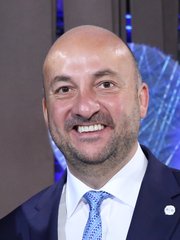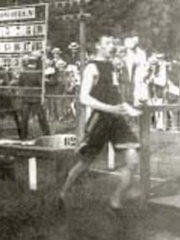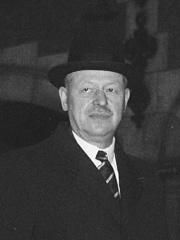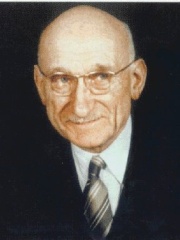
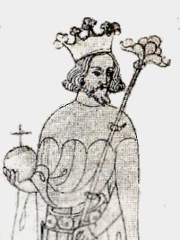
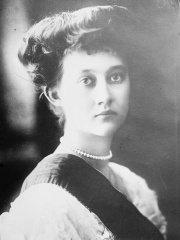
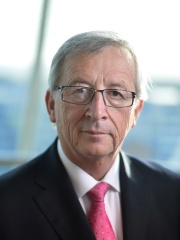
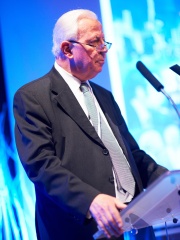
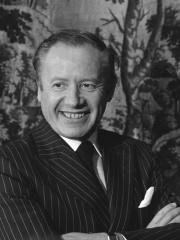
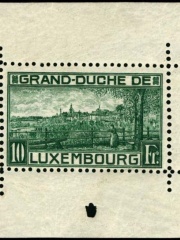
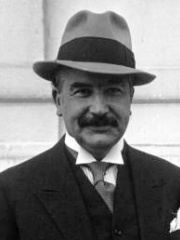
The Most Famous
POLITICIANS from Luxembourg
This page contains a list of the greatest Luxembourger Politicians. The pantheon dataset contains 19,576 Politicians, 28 of which were born in Luxembourg. This makes Luxembourg the birth place of the 94th most number of Politicians behind Nigeria, and Cambodia.
Top 10
The following people are considered by Pantheon to be the top 10 most legendary Luxembourger Politicians of all time. This list of famous Luxembourger Politicians is sorted by HPI (Historical Popularity Index), a metric that aggregates information on a biography's online popularity. Visit the rankings page to view the entire list of Luxembourger Politicians.

1. Robert Schuman (1886 - 1963)
With an HPI of 77.93, Robert Schuman is the most famous Luxembourger Politician. His biography has been translated into 63 different languages on wikipedia.
Jean-Baptiste Nicolas Robert Schuman (French: [ʁɔbɛʁ ʃuman]; 29 June 1886 – 4 September 1963) was a Luxembourg-born French statesman. Schuman was a Christian democratic (Popular Republican Movement) political thinker and activist. Twice Prime Minister of France, a reformist Minister of Finance and a Foreign Minister, he was instrumental in building postwar European and trans-Atlantic institutions and was one of the founders of the European Communities, the Council of Europe and NATO. The 1964–1965 academic year at the College of Europe was named in his honour. In 2021, Schuman was declared venerable by Pope Francis in recognition of his acting on Christian principles.

2. John of Bohemia (1296 - 1346)
With an HPI of 76.41, John of Bohemia is the 2nd most famous Luxembourger Politician. His biography has been translated into 50 different languages.
John of Bohemia, also called the Blind or of Luxembourg (Luxembourgish: Jang de Blannen; German: Johann der Blinde; Czech: Jan Lucemburský; 10 August 1296 – 26 August 1346), was the Count of Luxembourg from 1313 and King of Bohemia from 1310 and titular King of Poland. He is well known for having died while fighting in the Battle of Crécy at age 50, after having been blind for a decade. In his home country of Luxembourg, he is considered a national hero. Comparatively, in the Czech Republic (anciently the Kingdom of Bohemia), Jan Lucemburský is often recognized for his role as the father of Charles IV, Holy Roman Emperor, one of the more significant Kings of Bohemia and one of the leading Holy Roman Emperors.

3. Marie-Adélaïde, Grand Duchess of Luxembourg (1894 - 1924)
With an HPI of 74.59, Marie-Adélaïde, Grand Duchess of Luxembourg is the 3rd most famous Luxembourger Politician. Her biography has been translated into 42 different languages.
Marie-Adélaïde (French: Marie-Adélaïde Thérèse Hilda Wilhelmine, Luxembourgish: Marie-Adelheid; 14 June 1894 – 24 January 1924), was Grand Duchess of Luxembourg from 1912 until her abdication in 1919. She was the first Grand Duchess regnant of Luxembourg (after five grand dukes), its first female monarch since Duchess Maria Theresa (1740–1780, who was also an Austrian archduchess and Holy Roman Empress) and the first Luxembourgish monarch to be born within the territory since Count John the Blind (1296–1346). Named as heiress presumptive by her father Grand Duke William IV in 1907 to prevent a succession crisis due to his lack of a son, Marie-Adélaïde became Grand Duchess aged 18 upon his death in 1912. She ruled through the First World War, and her perceived support for the German occupation forces led to great unpopularity in Luxembourg as well as neighbouring France and Belgium. On the advice of Parliament and under enormous pressure from the Luxembourgish people, she abdicated on 14 January 1919 in favour of her younger sister Charlotte, who managed to save the monarchy and the dynasty in a national referendum later that year. Following her abdication, Marie-Adélaïde retired to a convent in Italy, before leaving due to ill health. She died of influenza in Germany on 24 January 1924, at the age of 29.

4. Jean-Claude Juncker (b. 1954)
With an HPI of 73.77, Jean-Claude Juncker is the 4th most famous Luxembourger Politician. His biography has been translated into 76 different languages.
Jean-Claude Juncker (Luxembourgish: [ˈʒɑ̃ːkloːt ˈjuŋkɐ]; born 9 December 1954) is a Luxembourgish politician who was prime minister of Luxembourg from 1995 to 2013 and president of the European Commission from 2014 to 2019. He also was Finance Minister from 1989 to 2009 and President of the Eurogroup from 2005 to 2013. By the time Juncker left office as prime minister in 2013, he was the longest-serving head of any national government in the EU and one of the longest-serving democratically elected leaders in the world, with his tenure encompassing the height of the European financial and sovereign debt crisis. In 2005, he became the first permanent President of the Eurogroup. In 2014, the European People's Party (EPP) had Juncker as its lead candidate, or Spitzenkandidat, for the presidency of the Commission in the 2014 elections. This marked the first time that the Spitzenkandidat process was employed. Juncker is the first president to have campaigned as a candidate for the position prior to the election, a process introduced with the Treaty of Lisbon. The EPP won 220 out of 751 seats in the Parliament. On 27 June 2014, the European Council officially nominated Juncker for the position, and the European Parliament elected him on 15 July 2014 with 422 votes out of the 729 cast. He took office on 1 November 2014 and served until 30 November 2019, when he was succeeded by Ursula von der Leyen. Juncker has stated that his priorities would be the creation of a digital single market, the development of an EU Energy Union, the negotiation of the Transatlantic Trade Agreement, the continued reform of the Economic and Monetary Union of the European Union—with the social dimension in mind, a "targeted fiscal capacity" for the Eurozone, and the 2015–2016 British EU membership renegotiations.
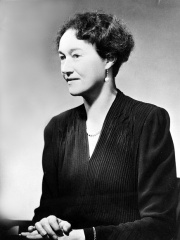
5. Charlotte, Grand Duchess of Luxembourg (1896 - 1985)
With an HPI of 71.81, Charlotte, Grand Duchess of Luxembourg is the 5th most famous Luxembourger Politician. Her biography has been translated into 42 different languages.
Charlotte (Charlotte Adelgonde Elisabeth Marie Wilhelmine; 23 January 1896 – 9 July 1985) was Grand Duchess of Luxembourg from 14 January 1919 until her abdication on 12 November 1964. Her reign is the longest of any Luxembourgish monarch since 1815 when the country was elevated to a Grand Duchy. She acceded to the throne on 14 January 1919 following the abdication of her sister, Marie-Adélaïde, due to political pressure over Marie-Adélaïde's role during the German occupation of Luxembourg during World War I. A referendum retained the monarchy with Charlotte as Grand Duchess regnant. She married Prince Felix of Bourbon-Parma on 6 November 1919. They had six children. Following the 1940 German invasion of Luxembourg during World War II, Charlotte went into exile: first in France, then Portugal, Great Britain, and North America. While in Britain, she made broadcasts to the people of Luxembourg. She returned to Luxembourg in April 1945. She abdicated in 1964, and was succeeded by her son, Jean, later dying from cancer on 9 July 1985. She was the last agnatic member of the House of Nassau, and the last personal recipient of the Golden Rose. Since her death, there are no living personal recipients of that honour, which in modern times has been awarded by the Pope only to churches and shrines. She is to date the most recent Grand Duchess of Luxembourg in her own right.

6. Jacques Santer (b. 1937)
With an HPI of 69.34, Jacques Santer is the 6th most famous Luxembourger Politician. His biography has been translated into 46 different languages.
Jacques Louis Santer (Luxembourgish pronunciation: [ʒaːk ˈsɑntə]; born 18 May 1937) is a Luxembourgish politician who served as president of the European Commission from 1995 to 1999 before resigning amidst allegations of corruption. He served as the finance minister of Luxembourg from 1979 until 1989, and as prime minister of Luxembourg from 1984 to 1995, as a member of the Christian Social People's Party (CSV), which was the leading party in the Luxembourgish government between 1979 and 2013. As prime minister of Luxembourg, he also led the negotiations on the Single European Act, which effectively set aside the 20-year-old Luxembourg compromise.

7. Gaston Thorn (1928 - 2007)
With an HPI of 67.10, Gaston Thorn is the 7th most famous Luxembourger Politician. His biography has been translated into 40 different languages.
Gaston Egmond Thorn (3 September 1928 – 26 August 2007) was a Luxembourgish politician who served in a number of high-profile positions, both domestically and internationally. He most prominently served as prime minister of Luxembourg (1974–1979), President of the United Nations General Assembly (1975), and president of the European Commission (1981–1985).

8. Princess Elisabeth, Duchess of Hohenberg (1922 - 2011)
With an HPI of 66.44, Princess Elisabeth, Duchess of Hohenberg is the 8th most famous Luxembourger Politician. Her biography has been translated into 22 different languages.
Princess Elisabeth, Duchess of Hohenberg (born Princess Elisabeth Hilda Zita Marie Anna Antonia Friederike Wilhelmine Luise of Luxembourg; 22 December 1922 – 22 November 2011) was a Luxembourgish princess, the daughter of Grand Duchess Charlotte and her husband, Prince Felix of Bourbon-Parma, the sister of Grand Duke Jean and the aunt of Grand Duke Henri. In 1956, she married Franz, Duke of Hohenberg.

9. Joseph Bech (1887 - 1975)
With an HPI of 66.11, Joseph Bech is the 9th most famous Luxembourger Politician. His biography has been translated into 28 different languages.
Joseph Bech (17 February 1887 – 8 March 1975) was a Luxembourgish politician and lawyer. He was the prime minister of Luxembourg, serving for eleven years, from 16 July 1926 to 5 November 1937. He returned to the position after World War II, and served for another four years, from 29 December 1953 until 29 March 1958. The 1982–1983 academic year at the College of Europe was named in his honour.
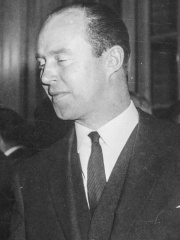
10. Prince Charles of Luxembourg (1927 - 1977)
With an HPI of 63.50, Prince Charles of Luxembourg is the 10th most famous Luxembourger Politician. His biography has been translated into 16 different languages.
Prince Charles of Luxembourg, Prince of Bourbon-Parma and Nassau (Charles Frédéric Louis Guillaume Marie; 7 August 1927 – 26 July 1977), was a younger son of Grand Duchess Charlotte and Prince Felix of Bourbon-Parma.
People
Pantheon has 28 people classified as Luxembourger politicians born between 1296 and 1973. Of these 28, 10 (35.71%) of them are still alive today. The most famous living Luxembourger politicians include Jean-Claude Juncker, Jacques Santer, and Viviane Reding. The most famous deceased Luxembourger politicians include Robert Schuman, John of Bohemia, and Marie-Adélaïde, Grand Duchess of Luxembourg. As of April 2024, 1 new Luxembourger politicians have been added to Pantheon including Etienne Schneider.
Living Luxembourger Politicians
Go to all RankingsJean-Claude Juncker
1954 - Present
HPI: 73.77
Jacques Santer
1937 - Present
HPI: 69.34
Viviane Reding
1951 - Present
HPI: 62.06
Luc Frieden
1963 - Present
HPI: 61.48
Xavier Bettel
1973 - Present
HPI: 60.14
Gabriela von Habsburg
1956 - Present
HPI: 58.78
Jean Asselborn
1949 - Present
HPI: 56.42
Lydie Polfer
1952 - Present
HPI: 56.15
Nicolas Schmit
1953 - Present
HPI: 54.10
Etienne Schneider
1971 - Present
HPI: 36.94
Deceased Luxembourger Politicians
Go to all RankingsRobert Schuman
1886 - 1963
HPI: 77.93
John of Bohemia
1296 - 1346
HPI: 76.41
Marie-Adélaïde, Grand Duchess of Luxembourg
1894 - 1924
HPI: 74.59
Charlotte, Grand Duchess of Luxembourg
1896 - 1985
HPI: 71.81
Gaston Thorn
1928 - 2007
HPI: 67.10
Princess Elisabeth, Duchess of Hohenberg
1922 - 2011
HPI: 66.44
Joseph Bech
1887 - 1975
HPI: 66.11
Prince Charles of Luxembourg
1927 - 1977
HPI: 63.50
Michel Théato
1878 - 1919
HPI: 61.65
Princess Marie Gabrielle of Luxembourg
1925 - 2023
HPI: 59.44
Pierre Dupong
1885 - 1953
HPI: 58.22
Pierre Frieden
1892 - 1959
HPI: 57.35
Newly Added Luxembourger Politicians (2025)
Go to all RankingsOverlapping Lives
Which Politicians were alive at the same time? This visualization shows the lifespans of the 16 most globally memorable Politicians since 1700.

